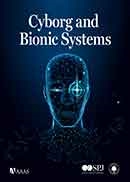首页 > SCI期刊 > SCIE期刊 > JCRQ1 > 期刊介绍

评价信息:
影响因子:10.5
年发文量:46
《机器人与仿生系统》(Cyborg And Bionic Systems)是一本以Engineering-Mechanical Engineering综合研究为特色的国际期刊。该刊由American Association for the Advancement of Science (AAAS)出版商该刊已被国际重要权威数据库SCIE收录。期刊聚焦Engineering-Mechanical Engineering领域的重点研究和前沿进展,及时刊载和报道该领域的研究成果,致力于成为该领域同行进行快速学术交流的信息窗口与平台。该刊2023年影响因子为10.5。CiteScore指数值为7.7。
Cyborg And Bionic Systems is an academic journal dedicated to the field of cyborg and biomimetic systems, covering a wide range of topics from basic research to application development, aiming to promote the development of this interdisciplinary field. With the rapid development of technology and the increasing demand for enhancing human abilities, treating diseases, and improving quality of life, the fields of cyborg and biomimetic systems have received widespread attention. The purpose of this magazine is to provide a platform for global researchers, engineers, clinical doctors, and students to exchange the latest research results, technological innovations, and clinical applications. This magazine covers various aspects of cyborg and biomimetic systems, including but not limited to neuroengineering and brain computer interfaces, bioelectronics and biosensors, prosthetics and rehabilitation engineering, applications of artificial intelligence and robotics technology in healthcare, biomaterials and tissue engineering, etc. As a professional journal dedicated to the field of cyborg and biomimetic systems, it provides a platform for global researchers to share knowledge, exchange experiences, and promote the development of the field.
《机器人与仿生系统》是一本专注于赛博格和仿生系统领域的学术期刊,涵盖了从基础研究到应用开发的广泛主题,旨在推动这一跨学科领域的发展。随着科技的快速发展和人们对增强人体能力、治疗疾病以及提高生活质量的需求日益增长,赛博格和仿生系统领域得到了广泛关注。该杂志的宗旨是为全球科研人员、工程师、临床医生和学生提供一个交流最新研究成果、技术创新和临床应用的平台。该杂志涵盖了赛博格和仿生系统的各个方面,包括但不限于神经工程与脑机接口、生物电子学与生物传感器、假肢与康复工程、人工智能与机器人技术在医疗中的应用、生物材料与组织工程等。作为一个专注于赛博格和仿生系统领域的专业期刊,为全球研究者提供了一个分享知识、交流经验和推动领域发展的平台。
如果您需要协助投稿或润稿服务,您可以咨询我们的客服老师。我们专注于期刊投稿服务十年,熟悉发表政策,可为您提供一对一投稿指导,避免您在投稿时频繁碰壁,节省您的宝贵时间,有效提升发表机率,确保SCI检索(检索不了全额退款)。我们视信誉为生命,多方面确保文章安全保密,在任何情况下都不会泄露您的个人信息或稿件内容。
JCR分区等级:Q1
| 按JIF指标学科分区 | 收录子集 | 分区 | 排名 | 百分位 |
| 学科:ENGINEERING, BIOMEDICAL | ESCI | Q1 | 7 / 122 |
94.7% |
| 学科:ROBOTICS | ESCI | Q1 | 3 / 46 |
94.6% |
| 按JCI指标学科分区 | 收录子集 | 分区 | 排名 | 百分位 |
| 学科:ENGINEERING, BIOMEDICAL | ESCI | Q1 | 8 / 122 |
93.85% |
| 学科:ROBOTICS | ESCI | Q1 | 6 / 46 |
88.04% |
| Gold OA文章占比 | 研究类文章占比 | 文章自引率 |
| 87.76% | 76.09% | |
| 开源占比 | 出版国人文章占比 | OA被引用占比 |
名词解释:JCR分区在学术期刊评价、科研成果展示、科研方向引导以及学术交流与合作等方面都具有重要的价值。通过对期刊影响因子的精确计算和细致划分,JCR分区能够清晰地反映出不同期刊在同一学科领域内的相对位置,从而帮助科研人员准确识别出高质量的学术期刊。
| CiteScore | SJR | SNIP | CiteScore 指数 | ||||||||||||||||||||
| 7.7 | 1.508 | 1.933 |
|
名词解释:CiteScore是基于Scopus数据库的全新期刊评价体系。CiteScore 2021 的计算方式是期刊最近4年(含计算年度)的被引次数除以该期刊近四年发表的文献数。CiteScore基于全球最广泛的摘要和引文数据库Scopus,适用于所有连续出版物,而不仅仅是期刊。目前CiteScore 收录了超过 26000 种期刊,比获得影响因子的期刊多13000种。被各界人士认为是影响因子最有力的竞争对手。
历年IF值(影响因子)
历年引文指标和发文量
历年自引数据
若用户需要出版服务,请联系出版商。